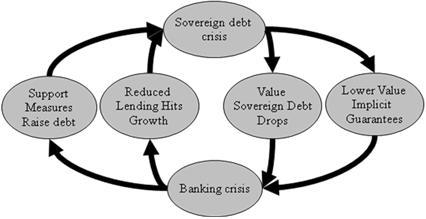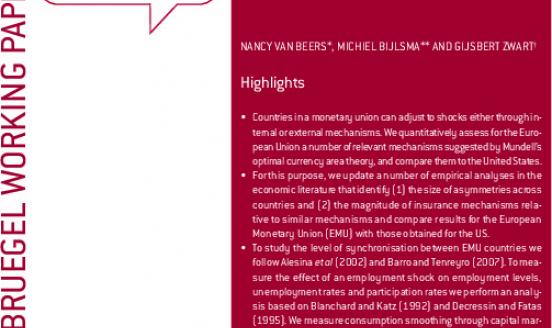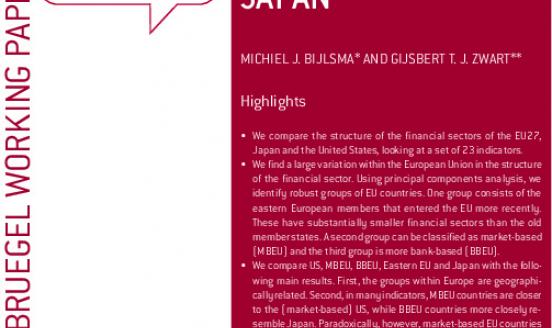A banking union is no panacea
The claim that the eurozone needs a banking union is by now almost universal (see here by Martin Wolf, here by Wolfgang Munchau, here by the European commission, and here by the ECB, see here for an overview of the recent debate). In addition, there seems to be more and more political support. Such a banking union first and foremost refers to a eurozone safety net and restructuring mechanism for banks. In addition it will inevitably imply regulation and supervision at a European level. A banking union is necessary for two reasons. First, bad regulation or inadequate recapitalisation in one country is potentially harmful to other countries, especially inside a monetary union. Second, as the example of Spain and Ireland show the burden of saving its own banks can prove excessive much for a sovereign and its tax payers.
But will a banking union be sufficient; in other words, will a banking union create a stable monetary union? There are at least three reasons to worry.
First, a banking union solves only part of the pernicious feedback-loop between countries and banks when these keep a large amount of their sovereign’s debt on their balance sheets. The figure below illustrates the feedback mechanism that connects sovereign debt and banking crises. A banking union will reduce the burden for sovereigns of bailing out banks while at the same time freeing banks of the effect of lower value of implicit guarantees. This cuts the outer loop. If, however, banks persist in keeping disproportional amount of their sovereigns’ debt on their balance sheets, the inner loop remains. This will be more likely if banks remain national. Consequently, a banking union may not prevent the destabilizing sudden stops that are quickly becoming the main force destabilizing the monetary union. Different versions of eurobond proposals will help in this respect as banks will then prefer eurobonds over national sovereign debt also cutting the inner feedback loop.

Second, in a monetary union with national banking systems, the funding of country deficits due to public or private spending will largely occur through loans provided by banks in a surplus country to banks in a deficit country. Even when two countries are in balance, there may be large bilateral exposures. The funding of investments in one country through short-term loans by banks in other countries exposes the former country to destabilizing runs reminiscent of sudden stops. This is not an imaginary possibility. If a bank in a particular country fails and the reason of failure is unclear, this may negatively affect other banks from that country. Investors may put some nonnegative probability on the possibility that the origin of the bank’s problems is national. This will then raise the funding costs for other banks from that country as well. In extreme cases, this may trigger an outflow of funds from a country.
In contrast, if banks are truly European, funds can flow from one country to another country without leaving a bank. No contracts are necessary. And when contracts are necessary, the context of such contracts is very different, if only because withdrawing funding from a subsidiary is most likely harmful for the parent bank as well due to reputation effects. This significantly reduces the probability of a run on the financial system in a particular country. An additional advantage is that European banks with significant presence in multiple countries can lend money directly to Spanish firms with profitable investment opportunities. This makes a credit crunch less likely and less severe reducing the feedback loop even further.
Third, in the absence of European banks, money fleeing Spain can flow back only indirectly through the build up of imbalances in the Target 2 payment system. National central banks then acts as a lender of last resort to ‘their’ banks, by providing funding in return for collateral. The burden if losses are incurred, however, is shared EMU-wide. This requires intensive monitoring of the quality of collateral by national banks that act as agents on behalf of the European central bank. In economic terms, the agents have to exert costly effort (monitoring) to contribute to a common good (the quality of collateral). This raises an important governance issue: how does the European central bank incentivise national banks to act on its behalf? The same issue arises with ex ante regulation of regional banks, which requires detailed knowledge of national market conditions and will most probably be left to the current national regulators. Because in a banking union the bank resolution framework and deposit insurance are European, individual countries no longer bear the full cost of lenient regulation. Again this raises the governance issues described above.
A banking union is undoubtedly a step towards stability. But if banks stay regional and hold disproportional amounts of national debt on their balance sheets, stability is not guaranteed, while at the same time a banking union calls for an overhaul of governance of national central banks.

